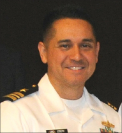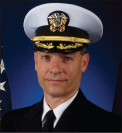The Public Manager Magazine Article
Surface Warfare Officers School Emphasizes Performance Assessment
A 2012 ASTD Excellence in Practice Award winner, the Naval Education and Training Command’s Surface Warfare Officers School (SWOS) aims to provide quality instruction for each of its students. Its innovative ship handling, naval engineering, and combat systems tactical-virtual learning technologies have helped achieve this vision. Recently SWOS discovered that its learning technologies were less than optimal in assessing student performance, so organizational leaders developed a strategy to improve its ability to provide properly trained officers to its primary customer, the U.S. Navy’s Fleet. SWOS used rigorous assessment tools to measure students’ skill levels and overall proficiency, and to provide student performance feedback and individually structured remediation. The Public Manager asked three Navy leaders from SWOS: “How do you ensure performance improvement for students who attend the Surface Warfare Officers School?”
Sat Sep 15 2012

A 2012 ASTD Excellence in Practice Award winner, the Naval Education and Training Command's Surface Warfare Officers School (SWOS) aims to provide quality instruction for each of its students. Its innovative ship handling, naval engineering, and combat systems tactical-virtual learning technologies have helped achieve this vision.
Recently SWOS discovered that its learning technologies were less than optimal in assessing student performance, so organizational leaders developed a strategy to improve its ability to provide properly trained officers to its primary customer, the U.S. Navy's Fleet. SWOS used rigorous assessment tools to measure students' skill levels and overall proficiency, and to provide student performance feedback and individually structured remediation.
The Public Manager asked three Navy leaders from SWOS: "How do you ensure performance improvement for students who attend the Surface Warfare Officers School?"

Joseph Torres
Director, Trainers and Simulation, SWOS Command
"Initially, SWOS functioned as a traditional schoolhouse with classroom sessions, PowerPoint presentations, and tests. Then we began using simulations for practical application. Shortly after we began using these simulations, we realized that we needed a way to better evaluate student progress and understanding, so we developed computer-based assessment tools that students must pass before they can leave the schoolhouse. The result: students now see the importance of focusing on each of the training stages, both the classroom piece and the simulations, and we've seen an improvement across the entire spectrum of learning."

Wyatt Chidester
Director, Maritime Warfighting and Department Head, Training
"We have a 27-week course for Naval officers. The classroom is made up of instructor-led training, computer-based training, and tactical trainers. The curriculum is meant to get students into a tactical trainer, where they are assessed on the knowledge they've learned over time. The course is divided into 10 modules, each of which students have to pass before they can move on. We assess via written exams, computer-based assessment tools, and oral boards for certain individuals."

George Ponsolle
Executive Director, SWOS Command
"There are three ways you can approach this problem. You can create a long-term memory training situation and have an independent assessor certify the performance of the students before they graduate. Second, you can identify critical courses, such as lieutenant department head training, and send surveys to ship commanding officers for performance feedback. Third, you can bring the officer back to the schoolhouse for level of knowledge and skill assessments—the current process used for division officers."
